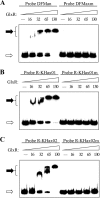Involvement of the global regulator GlxR in 3-hydroxybenzoate and gentisate utilization by Corynebacterium glutamicum
- PMID: 24795375
- PMCID: PMC4068664
- DOI: 10.1128/AEM.00290-14
Involvement of the global regulator GlxR in 3-hydroxybenzoate and gentisate utilization by Corynebacterium glutamicum
Abstract
Corynebacterium glutamicum is an industrially important producer of amino acids and organic acids, as well as an emerging model system for aromatic assimilation. An IclR-type regulator GenR has been characterized to activate the transcription of genDFM and genKH operons for 3-hydroxybenzoate and gentisate catabolism and represses its own expression. On the other hand, GlxR, a global regulator of the cyclic AMP (cAMP) receptor protein-fumarate nitrate reductase regulator (CRP-FNR) type, was also predicted to be involved in this pathway. In this study, electrophoretic mobility shift assays and footprinting analyses demonstrated that GlxR bound to three sites in the promoter regions of three gen operons. A combination of site-directed mutagenesis of the biding sites, promoter activity assay, and GlxR overexpression demonstrated that GlxR repressed their expression by binding these sites. One GlxR binding site (DFMx) was found to be located -13 to +8 bp upstream of the genDFM promoter, which was involved in negative regulation of genDFM transcription. The GlxR binding site R-KHx01 (located between positions -11 to +5) was upstream of the genKH promoter sequence and involved in negative regulation of its transcription. The binding site R-KHx02, at which GlxR binds to genR promoter to repress its expression, was found within a footprint extending from positions -71 to -91 bp. These results reveal that GlxR represses the transcription of all three gen operons and then contributes to the synchronization of their expression for 3-hydroxybenzoate and gentisate catabolism in collaboration with the specific regulator GenR.
Copyright © 2014, American Society for Microbiology. All Rights Reserved.
Figures






Similar articles
-
GenR, an IclR-type regulator, activates and represses the transcription of gen genes involved in 3-hydroxybenzoate and gentisate catabolism in Corynebacterium glutamicum.J Bacteriol. 2013 Apr;195(7):1598-609. doi: 10.1128/JB.02216-12. Epub 2013 Jan 25. J Bacteriol. 2013. PMID: 23354754 Free PMC article.
-
The GlxR regulon of the amino acid producer Corynebacterium glutamicum: in silico and in vitro detection of DNA binding sites of a global transcription regulator.J Biotechnol. 2008 Jul 31;135(4):340-50. doi: 10.1016/j.jbiotec.2008.05.011. Epub 2008 Jun 3. J Biotechnol. 2008. PMID: 18573287
-
Regulation of the nitrate reductase operon narKGHJI by the cAMP-dependent regulator GlxR in Corynebacterium glutamicum.Microbiology (Reading). 2011 Jan;157(Pt 1):21-28. doi: 10.1099/mic.0.044552-0. Epub 2010 Sep 23. Microbiology (Reading). 2011. PMID: 20864477
-
Degradation and assimilation of aromatic compounds by Corynebacterium glutamicum: another potential for applications for this bacterium?Appl Microbiol Biotechnol. 2012 Jul;95(1):77-89. doi: 10.1007/s00253-012-4139-4. Epub 2012 May 17. Appl Microbiol Biotechnol. 2012. PMID: 22588501 Review.
-
Transcriptional regulation of catabolic pathways for aromatic compounds in Corynebacterium glutamicum.Genet Mol Res. 2006 Dec 7;5(4):773-89. Genet Mol Res. 2006. PMID: 17183485 Review.
Cited by
-
Regulation of DNA phosphorothioate modification in Salmonella enterica by DndB.Sci Rep. 2015 Jul 20;5:12368. doi: 10.1038/srep12368. Sci Rep. 2015. PMID: 26190504 Free PMC article.
-
The ldhA Gene Encoding Fermentative l-Lactate Dehydrogenase in Corynebacterium Glutamicum Is Positively Regulated by the Global Regulator GlxR.Microorganisms. 2021 Mar 6;9(3):550. doi: 10.3390/microorganisms9030550. Microorganisms. 2021. PMID: 33800875 Free PMC article.
-
Global Regulator of Rubber Degradation in Gordonia polyisoprenivorans VH2: Identification and Involvement in the Regulation Network.Appl Environ Microbiol. 2020 Jul 20;86(15):e00774-20. doi: 10.1128/AEM.00774-20. Print 2020 Jul 20. Appl Environ Microbiol. 2020. PMID: 32444473 Free PMC article.
-
PnpM, a LysR-Type Transcriptional Regulator Activates the Hydroquinone Pathway in para-Nitrophenol Degradation in Pseudomonas sp. Strain WBC-3.Front Microbiol. 2017 Sep 14;8:1714. doi: 10.3389/fmicb.2017.01714. eCollection 2017. Front Microbiol. 2017. PMID: 28959240 Free PMC article.
References
Publication types
MeSH terms
Substances
LinkOut - more resources
Full Text Sources
Other Literature Sources
Molecular Biology Databases
Research Materials
Miscellaneous

